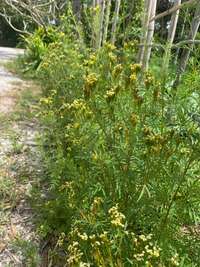The ECHO seedbank now has a type of marigold, Tagetes minuta (Asteraceae family.), that is different from the ornamental ones (e.g., T. patula and T. erecta) that gardeners may be used to. Native to South America, and spread worldwide with Spanish influence, T. minuta was first introduced into the USA to control root knot nematodes (Meloidogyne spp.) in California (CABI, 2021). T. minuta leaves are consumed, processed into essential oils, and used as a biopesticide. The FAO lists it as a weed (FAO, 2024), edible flower/spice (FAO, 2017), and illustrates its use for nematode control (FAO, 2015).

Figure 16. T. minuta at flowering stage. Source: Stacy Swartz
T. minuta is an herbaceous annual, with long stems branching from the center of the plant (Figure 16). T. minuta is taller than many of the smaller and more compact ornamental marigolds, growing up to 3 m tall. Small and mildly aromatic flowers attract butterflies. Plant leaves have oil producing glands that give T. minuta its flavor, herbal medicinal properties, and when properly used, its insect repellency.
Cultivation
Easy to grow and vigorous, T. minuta develops shallow, easy to pull roots (NC State Extension, 2017) partially alleviating its invasive potential. It prefers full sun to partial shade, flourishing in a variety of soil types, if they are well-drained. It tolerates a wide range of soil pH, with 4.5 to 7.0 being optimal. Plant seeds at a shallow depth (1-2 cm) in a well-prepared soil, or start seedlings in trays, transplanting plants after the roots are developed enough to survive. Fertilize before planting with compost or a complete (N-P-K) fertilizer. Mulch about 1 week after seedlings emerge. Water as necessary, avoiding wet leaves and puddling to help control diseases.
Pests
As an aromatic plant, T. minuta is naturally resistant to many pests. Root rot (Macrophomina phaseolina), bud rot (Alternaria nobilis), and leaf spots (A. tegetica), and stem rot (Sclerotinia sclerotiorum) are common (CABI, 2021). Depending on local incidence, spider mites (Tetranychus urticae), Japanese beetles (Popillia japonica), and slugs (phylum Mollusca) are common pests (NC State Extension, 2017).
Use of marigold in integrated pest management
Marigolds produces a substance called alpha-terthienyl, which reduces root-knot nematodes (Hooks et al., 2010, Kimenju et al., 2007, Kruegar et al., 2019, Siddiqui and Alam, 1987). It also contains the essential oil limonene, which reduces fungal and bacterial diseases and certain insects. Plant-parasitic nematodes infest marigolds, and the phytochemicals produced in the plant kill or render them unable to reproduce through ingestion or exposure. Nematodes will infest alternative host plants near marigolds. Therefore, establish dense plantings for more effective control of plant-parasitic nematodes.
Insect repellence is increased in enclosed areas (like greenhouses) where the aromatic essential oils (limonene) can have greater concentration and therefore more potent effect.
Culinary
The aromatic leaves are used to flavor foods and beverages in many ways. Oils are used industrially in many products.
References
CAB International. 2021. Tagetes minuta (stinking Roger). CABI Compendium. Wallingford, UK. https://doi.org/10.1079/cabicompendium.52642
FAO. 2024. Database of Weed Species in Crops and Countries. Food and Agricultural Organization of the United Nations. Rome, Italy.
FAO. 2017. Codex Alimentarius Commission. The Classification Of Food And Feed: Class A: Primary Food Commodities Of Plant Origin. Food and Agricultural Organization of the United Nations. Rome, Italy.
FAO. 2015. Organic Pest Management: Putting Prevention Ahead of Cure. Food and Agricultural Organization of the United Nations. Rome, Italy. https://www.fao.org/3/y4587e/y4587e13.pdf
Hooks, C.R.R., K-H. Wang, A. Ploeg, and R. McSorley. 2010. Using marigold (Tagetes spp.) as a cover crop to protect crops from plant-parasitic nematodes. Applied Soil Ecology 46:307-320.
Kimenju, J.W., A.M. Kagundu, J.H. Nderitu, F.M. Omuolo, and G.K. Mutua. 2007. Use of green manure plants in cropping systems to suppress root-knot nematodes. African Crop Science Conference Proceedings 8:1083-1085.
Krueger, R., K. E. Dover, R. McSorley, K. -H. Wang. 2019. Marigolds (Tagetes spp.) For Nematode Management. UF/IFAS Extension Pub. ENY-056. University of Florida, Gainesville, USA. https://edis.ifas.ufl.edu/publication/NG045
NC State Extension. 2017. North Carolina Extension Gardener Plant Toolbox. https://plants.ces.ncsu.edu/plants/tagetes/
Siddiqui, M.A. and M.M. Alam. 1987. Control of plant parasitic nematodes by intercropping with Tagetes minuta. Nematoloogia Mediterranea 15(2):205-211. https://journals.flvc.org/nemamedi/article/view/85623
Cite this article as:
Walle, R. 2024. Wild Marigold for Natural Pest Control and More. ECHO Development Notes no. 164.